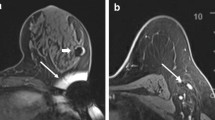Abstract
Purpose
Radiofrequency identification (RFID) tag localization (TL) is a technique of localizing non-palpable breast lesions that can be performed prior to surgery. We sought to evaluate whether TL is comparable to wire localization (WL) in regard to specimen size, operative time, and re-excision rate.
Methods
A retrospective cohort analysis was performed on TL and WL excisional biopsies and lumpectomies performed by 5 surgeons at 2 institutions. Cases were stratified by surgery type and surgical indication. Associations between localization technique and specimen volume, operative time, and re-excision rate were assessed by univariate and multivariate analyses.
Results
A total of 503 procedures were included, 147 TL (29.2%) and 356 WL (70.8%). Nineteen (12.9%) RFID tags were placed before surgery, ranging 1–22 days. All intended targets were removed. TL and WL excisional biopsy and lumpectomy specimen volumes were similar (p = 0.560 and 0.494). TL and WL excisional biopsy and lumpectomy + SLNB operative times were similar (p = 0.152 and 0.158), but TL lumpectomies without SLNB took longer than WL (57 min vs 49 min; p = 0.027). Re-excision rates were similar by surgical procedure (p = 0.615), surgical indication (DCIS p = 0.145; invasive carcinoma p = 0.759), and confirmed by multivariable analysis (OR 0.754, 95% CI 0.392–1.450; p = 0.397).
Conclusions
TL has similar surgical outcomes to WL with added benefit that TL can occur prior to the day of surgery. TL is an acceptable alternative to WL and should be considered for non-palpable breast lesions.

Similar content being viewed by others
References
Fisher B et al (2002) Twenty-year follow-up of a randomized trial comparing total mastectomy, lumpectomy, and lumpectomy plus irradiation for the treatment of invasive breast cancer. N Engl J Med 347(16):1233–1241
Veronesi U et al (2002) Twenty-year follow-up of a randomized study comparing breast-conserving surgery with radical mastectomy for early breast cancer. N Engl J Med 347(16):1227–1232
Lautner M et al (2015) Disparities in the use of breast-conserving therapy among patients with early-stage breast cancer. JAMA Surg 150(8):778–786
Lovrics PJ et al (2009) The relationship between surgical factors and margin status after breast-conservation surgery for early stage breast cancer. Am J Surg 197(6):740–746
Hayes MK (2017) Update on preoperative breast localization. Radiol Clin N Am 55(3):591–603
Mayo RC 3rd, Kalambo MJ, Parikh JR (2019) Preoperative localization of breast lesions: current techniques. Clin Imaging 56:1–8
In 't Hout BA et al (2016) Efficacy of localization of non-palpable, invasive breast cancer: wire localization vs. Iodine-125 seed: a historical comparison. Breast 29:8–13
Parvez E et al (2018) Adoption and outcomes of radioguided seed localization for non-palpable invasive and in situ breast cancer at three academic tertiary care centers. Am J Surg 216(6):1160–1165
Murphy JO et al (2013) Radioactive seed localization compared to wire localization in breast-conserving surgery: initial 6-month experience. Ann Surg Oncol 20(13):4121–4127
Tran VT et al (2017) Comparative evaluation of Iodine-125 radioactive seed localization and wire localization for resection of breast lesions. Can Assoc Radiol J 68(4):447–455
Dauphine C et al (2015) A prospective clinical study to evaluate the safety and performance of wireless localization of nonpalpable breast lesions using radiofrequency identification technology. AJR Am J Roentgenol 204(6):W720–W723
Reicher JJ et al (2008) Radio frequency identification tags for preoperative tumor localization: proof of concept. AJR Am J Roentgenol 191(5):1359–1365
DiNome ML et al (2019) Microchipping the breast: an effective new technology for localizing non-palpable breast lesions for surgery. Breast Cancer Res Treat 175:165–170
Wapnir IL, Wartenberg DE, Greco RS (1996) Three dimensional staging of breast cancer. Breast Cancer Res Treat 41(1):15–19
Luiten JD et al (2015) Iodine seed- versus wire-guided localization in breast-conserving surgery for non-palpable ductal carcinoma in situ. Br J Surg 102(13):1665–1669
Boughey JC et al (2013) Sentinel lymph node surgery after neoadjuvant chemotherapy in patients with node-positive breast cancer: the ACOSOG Z1071 (Alliance) clinical trial. JAMA 310(14):1455–1461
Caudle AS et al (2016) Improved axillary evaluation following neoadjuvant therapy for patients with node-positive breast cancer using selective evaluation of clipped nodes: implementation of targeted axillary dissection. J Clin Oncol 34(10):1072–1078
Boughey JC et al (2016) Identification and resection of clipped node decreases the false-negative rate of sentinel lymph node surgery in patients presenting with node-positive breast cancer (T0-T4, N1-N2) who receive neoadjuvant chemotherapy: results from ACOSOG Z1071 (alliance). Ann Surg 263(4):802–807
Woods RW et al (2019) A review of options for localization of axillary lymph nodes in the treatment of invasive breast cancer. Acad Radiol 26(6):805–819
Acknowledgements
Dr. Hughes is a speaker for Hologic. Dr. Dontchos is a consultant for GE Healthcare. Drs. McGugin, Spivey, Coopey, Smith, Kelly, Gadd, and Specht have no disclosures to report.
Author information
Authors and Affiliations
Corresponding author
Ethics declarations
Conflict of interest
Dr. McGugin declares that she has no conflict of interest. Dr. Spivey declares that she has no conflict of interest. Dr. Coopey declares that she has no conflict of interest. Dr. Smith declares that she has no conflict of interest. Ms. Kelly declares that she has no conflict of interest. Dr. Gadd declares that she has no conflict of interest. Dr. Hughes has received a speaker honorarium from Hologic. Dr. Dontchos has provided consultant work for GE Healthcare. Dr. Specht declares that she has no conflict of interest.
Ethical approval
All procedures performed in studies involving human participants were in accordance with the ethical standards of the institutional and/or national research committee and with the 1964 Helsinki declaration and its later amendments or comparable ethical standards.
Informed consent
Informed consent was obtained from all individual participants included in the study.
Research involved in human or animal rights
This article does not contain any studies with animals performed by any of the authors.
Additional information
Publisher's Note
Springer Nature remains neutral with regard to jurisdictional claims in published maps and institutional affiliations.
Rights and permissions
About this article
Cite this article
McGugin, C., Spivey, T., Coopey, S. et al. Radiofrequency identification tag localization is comparable to wire localization for non-palpable breast lesions. Breast Cancer Res Treat 177, 735–739 (2019). https://doi.org/10.1007/s10549-019-05355-0
Received:
Accepted:
Published:
Issue Date:
DOI: https://doi.org/10.1007/s10549-019-05355-0




